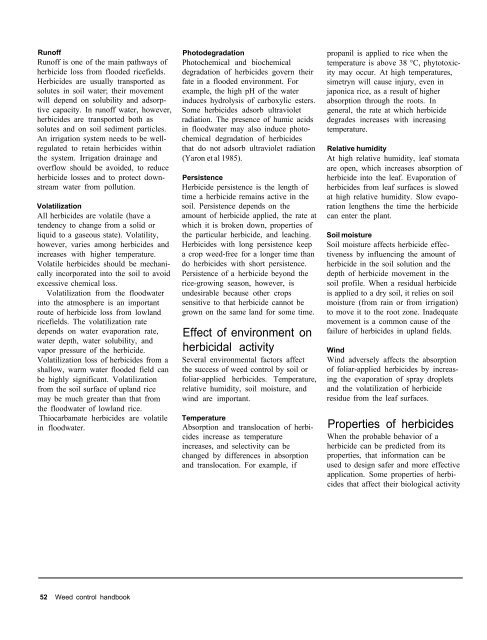A handbbok on Weed Control in Rice.pdf
A handbbok on Weed Control in Rice.pdf
A handbbok on Weed Control in Rice.pdf
You also want an ePaper? Increase the reach of your titles
YUMPU automatically turns print PDFs into web optimized ePapers that Google loves.
Runoff<br />
Runoff is <strong>on</strong>e of the ma<strong>in</strong> pathways of<br />
herbicide loss from flooded ricefields.<br />
Herbicides are usually transported as<br />
solutes <strong>in</strong> soil water; their movement<br />
will depend <strong>on</strong> solubility and adsorp-<br />
tive capacity. In runoff water, however,<br />
herbicides are transported both as<br />
solutes and <strong>on</strong> soil sediment particles.<br />
An irrigati<strong>on</strong> system needs to be well-<br />
regulated to reta<strong>in</strong> herbicides with<strong>in</strong><br />
the system. Irrigati<strong>on</strong> dra<strong>in</strong>age and<br />
overflow should be avoided, to reduce<br />
herbicide losses and to protect down-<br />
stream water from polluti<strong>on</strong>.<br />
Volatilizati<strong>on</strong><br />
All herbicides are volatile (have a<br />
tendency to change from a solid or<br />
liquid to a gaseous state). Volatility,<br />
however, varies am<strong>on</strong>g herbicides and<br />
<strong>in</strong>creases with higher temperature.<br />
Volatile herbicides should be mechani-<br />
cally <strong>in</strong>corporated <strong>in</strong>to the soil to avoid<br />
excessive chemical loss.<br />
Volatilizati<strong>on</strong> from the floodwater<br />
<strong>in</strong>to the atmosphere is an important<br />
route of herbicide loss from lowland<br />
ricefields. The volatilizati<strong>on</strong> rate<br />
depends <strong>on</strong> water evaporati<strong>on</strong> rate,<br />
water depth, water solubility, and<br />
vapor pressure of the herbicide.<br />
Volatilizati<strong>on</strong> loss of herbicides from a<br />
shallow, warm water flooded field can<br />
be highly significant. Volatilizati<strong>on</strong><br />
from the soil surface of upland rice<br />
may be much greater than that from<br />
the floodwater of lowland rice.<br />
Thiocarbamate herbicides are volatile<br />
<strong>in</strong> floodwater.<br />
52 <strong>Weed</strong> c<strong>on</strong>trol handbook<br />
Photodegradati<strong>on</strong><br />
Photochemical and biochemical<br />
degradati<strong>on</strong> of herbicides govern their<br />
fate <strong>in</strong> a flooded envir<strong>on</strong>ment. For<br />
example, the high pH of the water<br />
<strong>in</strong>duces hydrolysis of carboxylic esters.<br />
Some herbicides adsorb ultraviolet<br />
radiati<strong>on</strong>. The presence of humic acids<br />
<strong>in</strong> floodwater may also <strong>in</strong>duce photo-<br />
chemical degradati<strong>on</strong> of herbicides<br />
that do not adsorb ultraviolet radiati<strong>on</strong><br />
(Yar<strong>on</strong> et al 1985).<br />
Persistence<br />
Herbicide persistence is the length of<br />
time a herbicide rema<strong>in</strong>s active <strong>in</strong> the<br />
soil. Persistence depends <strong>on</strong> the<br />
amount of herbicide applied, the rate at<br />
which it is broken down, properties of<br />
the particular herbicide, and leach<strong>in</strong>g.<br />
Herbicides with l<strong>on</strong>g persistence keep<br />
a crop weed-free for a l<strong>on</strong>ger time than<br />
do herbicides with short persistence.<br />
Persistence of a herbicide bey<strong>on</strong>d the<br />
rice-grow<strong>in</strong>g seas<strong>on</strong>, however, is<br />
undesirable because other crops<br />
sensitive to that herbicide cannot be<br />
grown <strong>on</strong> the same land for some time.<br />
Effect of envir<strong>on</strong>ment <strong>on</strong><br />
herbicidal activity<br />
Several envir<strong>on</strong>mental factors affect<br />
the success of weed c<strong>on</strong>trol by soil or<br />
foliar-applied herbicides. Temperature,<br />
relative humidity, soil moisture, and<br />
w<strong>in</strong>d are important.<br />
Temperature<br />
Absorpti<strong>on</strong> and translocati<strong>on</strong> of herbi-<br />
cides <strong>in</strong>crease as temperature<br />
<strong>in</strong>creases, and selectivity can be<br />
changed by differences <strong>in</strong> absorpti<strong>on</strong><br />
and translocati<strong>on</strong>. For example, if<br />
propanil is applied to rice when the<br />
temperature is above 38 °C, phytotoxic-<br />
ity may occur. At high temperatures,<br />
simetryn will cause <strong>in</strong>jury, even <strong>in</strong><br />
jap<strong>on</strong>ica rice, as a result of higher<br />
absorpti<strong>on</strong> through the roots. In<br />
general, the rate at which herbicide<br />
degrades <strong>in</strong>creases with <strong>in</strong>creas<strong>in</strong>g<br />
temperature.<br />
Relative humidity<br />
At high relative humidity, leaf stomata<br />
are open, which <strong>in</strong>creases absorpti<strong>on</strong> of<br />
herbicide <strong>in</strong>to the leaf. Evaporati<strong>on</strong> of<br />
herbicides from leaf surfaces is slowed<br />
at high relative humidity. Slow evapo-<br />
rati<strong>on</strong> lengthens the time the herbicide<br />
can enter the plant.<br />
Soil moisture<br />
Soil moisture affects herbicide effec-<br />
tiveness by <strong>in</strong>fluenc<strong>in</strong>g the amount of<br />
herbicide <strong>in</strong> the soil soluti<strong>on</strong> and the<br />
depth of herbicide movement <strong>in</strong> the<br />
soil profile. When a residual herbicide<br />
is applied to a dry soil, it relies <strong>on</strong> soil<br />
moisture (from ra<strong>in</strong> or from irrigati<strong>on</strong>)<br />
to move it to the root z<strong>on</strong>e. Inadequate<br />
movement is a comm<strong>on</strong> cause of the<br />
failure of herbicides <strong>in</strong> upland fields.<br />
W<strong>in</strong>d<br />
W<strong>in</strong>d adversely affects the absorpti<strong>on</strong><br />
of foliar-applied herbicides by <strong>in</strong>creas-<br />
<strong>in</strong>g the evaporati<strong>on</strong> of spray droplets<br />
and the volatilizati<strong>on</strong> of herbicide<br />
residue from the leaf surfaces.<br />
Properties of herbicides<br />
When the probable behavior of a<br />
herbicide can be predicted from its<br />
properties, that <strong>in</strong>formati<strong>on</strong> can be<br />
used to design safer and more effective<br />
applicati<strong>on</strong>. Some properties of herbi-<br />
cides that affect their biological activity











